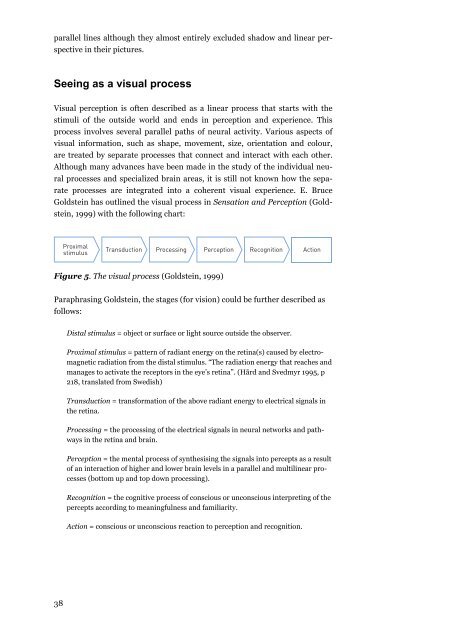Lightness and Brightness and Other Confusions
Lightness and Brightness and Other Confusions
Lightness and Brightness and Other Confusions
Create successful ePaper yourself
Turn your PDF publications into a flip-book with our unique Google optimized e-Paper software.
parallel lines although they almost entirely excluded shadow <strong>and</strong> linear perspective<br />
in their pictures.<br />
Seeing as a visual process<br />
Visual perception is often described as a linear process that starts with the<br />
stimuli of the outside world <strong>and</strong> ends in perception <strong>and</strong> experience. This<br />
process involves several parallel paths of neural activity. Various aspects of<br />
visual information, such as shape, movement, size, orientation <strong>and</strong> colour,<br />
are treated by separate processes that connect <strong>and</strong> interact with each other.<br />
Although many advances have been made in the study of the individual neural<br />
processes <strong>and</strong> specialized brain areas, it is still not known how the separate<br />
processes are integrated into a coherent visual experience. E. Bruce<br />
Goldstein has outlined the visual process in Sensation <strong>and</strong> Perception (Goldstein,<br />
1999) with the following chart:<br />
Proximal<br />
stimulus<br />
Transduction Processing Perception Recognition Action<br />
Figure 5. The visual process (Goldstein, 1999)<br />
Paraphrasing Goldstein, the stages (for vision) could be further described as<br />
follows:<br />
Distal stimulus = object or surface or light source outside the observer.<br />
Proximal stimulus = pattern of radiant energy on the retina(s) caused by electromagnetic<br />
radiation from the distal stimulus. “The radiation energy that reaches <strong>and</strong><br />
manages to activate the receptors in the eye’s retina”. (Hård <strong>and</strong> Svedmyr 1995, p<br />
218, translated from Swedish)<br />
Transduction = transformation of the above radiant energy to electrical signals in<br />
the retina.<br />
Processing = the processing of the electrical signals in neural networks <strong>and</strong> pathways<br />
in the retina <strong>and</strong> brain.<br />
Perception = the mental process of synthesising the signals into percepts as a result<br />
of an interaction of higher <strong>and</strong> lower brain levels in a parallel <strong>and</strong> multilinear processes<br />
(bottom up <strong>and</strong> top down processing).<br />
Recognition = the cognitive process of conscious or unconscious interpreting of the<br />
percepts according to meaningfulness <strong>and</strong> familiarity.<br />
Action = conscious or unconscious reaction to perception <strong>and</strong> recognition.<br />
38
















